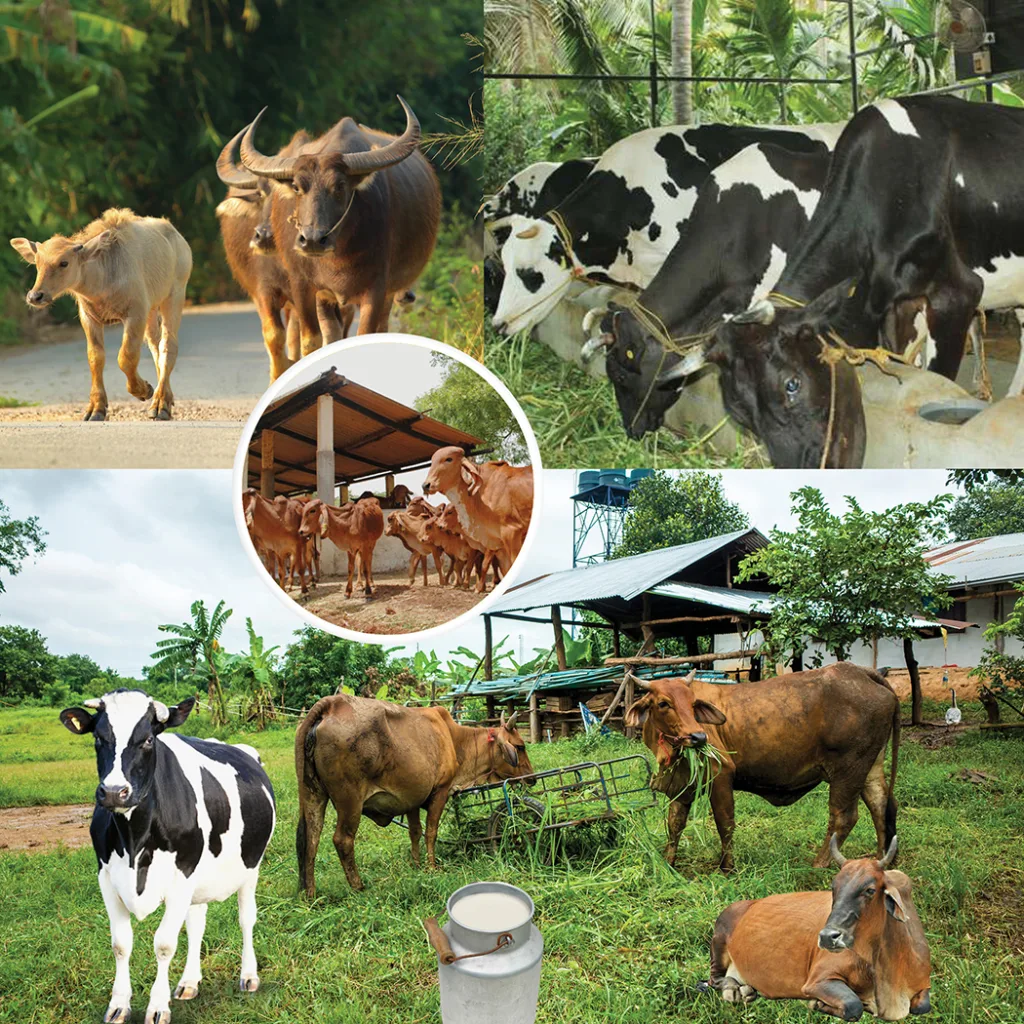Milk is a key part of the Indian diet because it provides essential nutrients like proteins, vitamins, and minerals. People are drinking more milk and eating more milk products to stay healthy, which highlights how important the dairy industry is in India.
The Importance of Dairy Farming in India: A Deeper Dive
Dairy farming, traditionally a cornerstone of India’s agricultural sector, has gained even more prominence in recent years for multiple reasons:
- Nutritional Security: As a provider of essential nutrients like proteins, vitamins, and minerals, milk is a staple in the Indian diet. The increasing consumption of milk products to meet nutritional needs emphasizes the importance of the dairy sector.
- Employment: Dairy farming is a major source of employment in rural India. For many, it provides a primary or additional income stream, thereby playing a crucial role in poverty reduction.
- Economic Impact: As the world’s largest milk producer, India’s dairy industry contributes significantly to its GDP. The growth potential in this sector makes it crucial to the economy.
- Women’s Empowerment: Dairy farming, often done at home, allows women in rural areas to earn money and support their families. This activity not only helps them financially but also encourages them to become entrepreneurs.
Estimating the Investment: Cost to Start a Dairy Farm
The cost of starting a dairy farm in India primarily depends on the size of the farm and the number of cattle. Here’s a basic financial plan for a beginner’s dairy farm.
- Land: Rent or buy a land area that can accommodate the size of your farm. Land costs can range between INR 10,000 to INR 100,000 per acre, depending on the location.
- Infrastructure: Barns, sheds, feeding troughs, and milking equipment cost around INR 500,000 for a small-scale farm.
- Cattle: Each good-quality milch cow can cost INR 50,000 to INR 70,000. The cost varies based on the breed.
- Feed: Allocate around INR 10,000 per cow annually for fodder and nutrition supplements.
- Labor: Budget around INR 10,000 per month per worker for labor costs.
- Miscellaneous Expenses: Vaccinations, veterinary visits, transportation and other unforeseen expenses should also be factored in.
Thus, a basic dairy farm setup with ten cows can cost approximately INR 10,00,000 to INR 15,00,000.
Exploiting the Advantages: Benefits of the Dairy Business in India
Dairy farming holds a distinct position in the Indian economy due to its numerous benefits.
- Growing Demand: The dairy market in India is expanding, driven by rising consumption of milk and milk products.
- Profitability: With a strategic business plan and effective management, dairy farming can generate high returns on investment.
- Government Support: The government offers various subsidies and loan facilities to promote dairy farming. Check out the ffreedom app’s dairy farming course to get more information on these opportunities.
- Sustainable Business: Dairy farming contributes to sustainability as it encourages local production and consumption.
Choosing the Best: Selecting Breeds for Your Dairy Business
Different dairy breeds offer varied milk production capabilities. Consider the following popular breeds for high milk yield:
- Holstein Friesian: Holstein Friesian is known for its high milk yield, suitable for commercial dairy farming.
- Jersey: Jersey cow provides high-quality milk with good fat content.
- Sahiwal: An Indian breed, hardy and heat-resistant, suitable for tropical climates.
- Gir: Gir is another Indian breed, known for high milk production and adaptability to diverse climatic conditions.
Browse through the ffreedom app dairy farming courses for more comprehensive insights on breed selection.

Planning for Success: Dairy Farming Business Plan
A well-laid business plan is the cornerstone of a successful dairy farm.
- Market Analysis: Understand the local demand for milk and dairy products, existing competition and pricing strategies.
- Breeding Plan: Develop a breeding plan to ensure a consistent milk supply.
- Feed Management Plan: Plan your fodder production or purchasing strategy to ensure a steady feed supply.
- Healthcare Plan: Arrange regular veterinary visits, vaccinations and health check-ups for your cattle.
- Marketing Strategy: Determine how to market your products. Consider direct selling, supplying to local dairies or collaborating with larger dairy brands.
Assessing Profitability: Is Dairy Farm Profitable in India?
Yes, dairy farming can be highly profitable in India. Factors like increasing demand, government subsidies and the potential for local-to-global expansion make it an attractive venture. However, success depends largely on the management practices and the marketing strategy of the farm.
Delving Deeper: Types of Dairy Farming
There are different types of dairy farming methods, each with its own set of advantages:
- Commercial Dairy Farming: Involves large-scale production of milk for commercial purposes. It demands a significant initial investment but yields high returns.
- Subsistence Dairy Farming: Milk production is primarily for the farmer’s household, with excess sold in the local market.
- Organic Dairy Farming: Adheres to organic production methods. Organic products can fetch premium prices but require stringent compliance with organic farming standards.
So, starting a dairy farm in India can indeed be a rewarding venture, provided you have a strategic business plan, select the right cattle breed, manage costs effectively and exploit the benefits of the booming dairy industry. Embark on this fulfilling journey and contribute to India’s milk production story.

Step-by-Step Guide to Setting Up and Running a Dairy Farm in India
Once you’ve settled on the business plan and obtained the necessary funding, it’s time to dive into the specifics of setting up and operating your dairy farm.
1. Building the Shed
The first physical aspect to consider is the cattle shed. It should be well-ventilated, clean and spacious enough for your cattle. Orient the shed in a direction that minimizes exposure to strong winds or excessive sunlight. The floor should be inclined to aid cleaning, and each animal should have approximately 40-60 square feet of space.
2. Water Supply
Maintain a constant and clean water supply for your cattle. Adult cows consume between 40 to 60 liters of water daily. Providing fresh water improves their health and productivity.
3. Procuring Feed and Feeding Cattle
Cattle feed constitutes a significant portion of the operating costs. High-quality feed results in better milk production. A typical cow’s diet consists of green fodder, dry fodder, and concentrates.
Feeding should ideally be done twice a day – once in the morning and once in the evening. Adhering to a consistent feeding schedule is crucial for the cows’ health and productivity.
4. Controlling Cattle
Train your cattle early for easy handling. Techniques such as positive reinforcement can be helpful. Additionally, use sturdy, but not harmful, restraining equipment when necessary.
5. Milk Extraction, Storage, and Packaging
Milking should be done at consistent times every day. Sanitize the udder before and after milking to prevent infections. Depending on your scale, you may opt for manual milking or use milking machines.
After extraction, milk should be rapidly cooled to below 4°C to prevent bacterial growth. Pasteurization is also crucial to kill any existing bacteria. Once cooled and pasteurized, the milk should be stored in stainless steel or aluminium containers to avoid any contamination.
Packaging should be done in sterilized containers. Depending on your market, you can opt for pouches, glass bottles or plastic containers. Remember to include important information like the production date and nutritional details on the packaging.
6. Disease Management and Vet Care
Regular health checks are crucial to prevent and control diseases. Maintain a close relationship with a vet and follow their recommendations regarding vaccinations and treatments.
Starting and running a dairy farm involves careful planning and attention to detail. However, the benefits of the dairy business in India, from the high demand to the potential for profitability, make it a worthwhile endeavor
ffreedom App: Comprehensive Learning Platform for Dairy Farming
The ffreedom app offers a well-rounded dairy farming course, providing aspiring dairy farmers with the necessary knowledge, skills and mentorship to establish and operate a successful dairy business.
The course, offered in six languages, covers a broad spectrum of dairy farming aspects:
- Starting Up: Detailed guidance on initiating a dairy farm, such as identifying a suitable location, choosing the right breed of cattle, and setting up infrastructure.
- Maintenance: Comprehensive lessons on daily farming activities, including feeding schedules, milking procedures, maintaining hygiene and sanitation and waste management.
- Disease Management: Information about common cattle diseases, their symptoms, preventive measures, and treatments. This knowledge is crucial for maintaining a healthy herd and ensuring consistent milk production.
- Marketing Strategies: Effective methods to market and sell dairy products, with a focus on identifying target markets, setting competitive prices, and leveraging different sales channels.
- Business Management: In-depth sessions on managing a dairy business, including cost management, revenue generation, profitability analysis and expansion strategies.
What sets the ffreedom app course apart is its panel of successful mentors from the dairy farming industry. These seasoned professionals share their practical experiences and insights, providing a real-world perspective to theoretical knowledge. The course is thus a holistic learning resource, perfectly tailored for India’s future dairy farmers. Download ffreedom app now.



